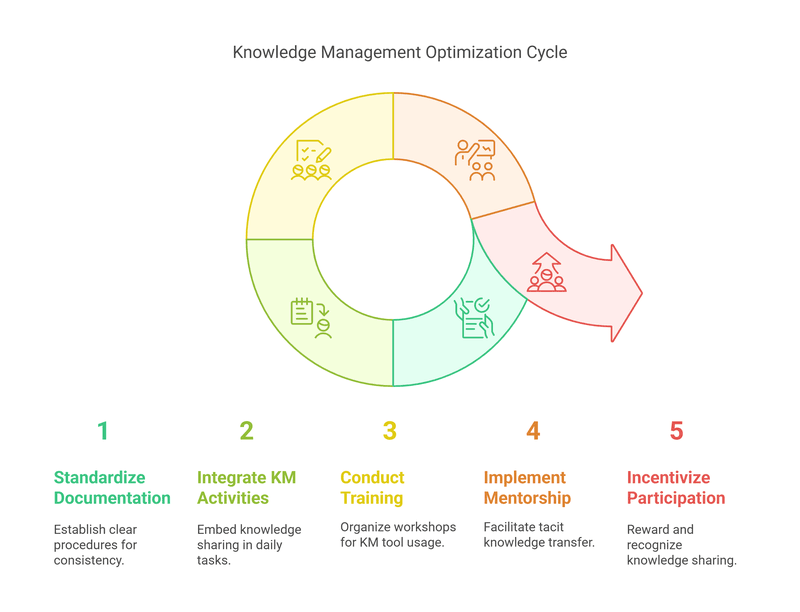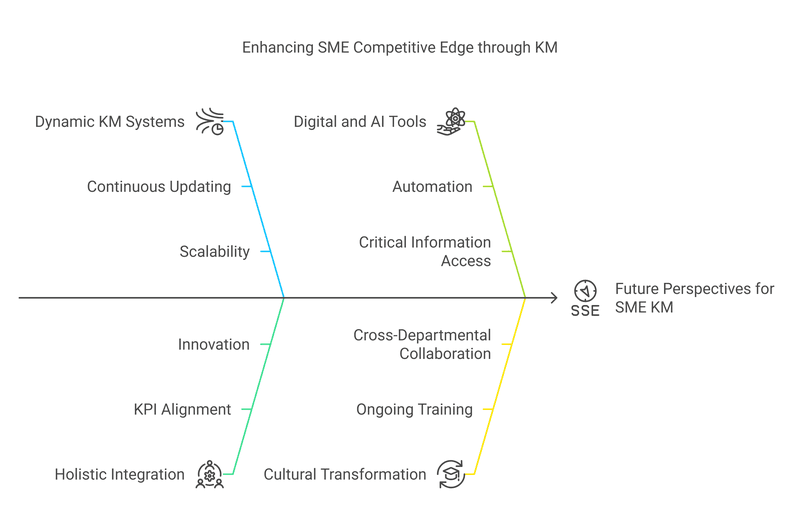SMEs Knowledge Management — Between Compliance and Holistic Integration
How a focus on certification requirements and isolated IT solutions limits SMEs in their culture of knowledge – and which approaches manage the balancing act between just obligatory compliance and strategic know-how.

1. Introduction: Context and Objectives
Nowadays, Knowledge Management has become one of the challenges of competitiveness and of innovation —particularly for the small and medium-sized enterprises (SMEs) in a business environment full of innovation. "The importance of Knowledge Management is established, however many SMEs implement Knowledge Management as part of meeting their certification criteria like ISO 9001 and not as part of their strategic business asset. In this article, we will take a closer look at what that gulf between barebones, box-ticking knowledge management and a healthy, habit-forming knowledge culture looks like.
1.1 The Current Situation in SMEs
External auditors and certification bodies often require that businesses adopt Knowledge Management and this is why many SMEs do. You buy and implement standard software solutions, but very few times are these efforts, followed by a deep organizational or cultural transformation. Consequently the initial tick-box exercise becomes a patchwork of don’t shares with limited use in providing strategic value. That is, empirical studies have shown that in situations where Knowledge Management is [primarily] operated for compliance purposes, key insights and tacit know-how have tended to stay locked away in departmental vaults (or silos).
1.2 Objectives of the Article
This article has three objectives:
- Discuss the idea of “minimalistic implementation” of Knowledge Management in SMEs & its problems
- Discuss empirical evidence and academic research that demonstrate the implementation gap in a number of SMEs.
- Building on these insights, develop actionable recommendations to embed Knowledge Management as a continuously evolving strategic process within an organization’s core structure. This approach elevates it from a mere compliance measure to a sustainable competitive advantage.
2. A compliance-oriented, minimalistic implementation
2.1 Knowledge management as a mandatory exercise
In numerous Small and Medium Enterprises, Knowledge Management is perceived as a mandatory activity, a checkbox to be ticked for accreditation. Many companies turn to ready-made commercial software solutions that were developed to achieve documentation of procedures or to satisfy ISO 9001:2015 requirements. Yet, this strategy fails to recognize two essential components: the embedding of Knowledge Management into an organization's quotidian activity and, more importantly, the cultural changes necessary to promote sharing and capturing of critical knowledge.
For example, an SME may put in place a document management system purely to meet the requirements of an external audit, but it doesn't change the way business is done, nor does it create a climate in which employees feel incentivised to share their knowledge. As a result, you have a static repository that only captures information at a single point in time and does not respond to the company’s changing needs.
2.2 Consequences of a Pure Compliance Approach
Here are a few adverse outcomes of a compliance-centric Knowledge Management strategy:
- Knowledge Silos:
Knowledge Management works in silos restricted to departments purely for certification.people believe in Knowledge Management because they perceive knowledge in pieces. Such fragmentation hinders the movement of knowledge through the organization, creating opportunities lost and efforts duplicated. - Lack of Sustainability:
Minimum measures typically lead to ad-hoc initiatives. After achieving certification, there is little motivation to update, expand, or synthesize the knowledge repository. The system will stagnate without ongoing maintenance, becoming outdated and serving none of its strategic aims. - Missed Strategic Potential:
This is not leveraging the true power of Knowledge Management, which would be a system not just built for compliance, but for the opportunity to capture why you do what you do. Instead of enabling innovation and strategic decision-making, such systems become static archives that rarely affect current action or future strategy.
Many studies have shown that SMEs use the Knowledge Management approach more as a short term, compliance project than a strategic, cross-company project. This experience highlights the notion that Knowledge Management is no more than a stretch goal unless it is treated as part of the >ever, both why procedures are more effective when they are reward-inclusive and why Knowledge Management needs to be also seen through the lens of a win-win approach.
3. Problems of Implementation
3.1 Standalone IT Solutions and Poor Integration
A major issue with this approach right now is that it still biggest of IT solutions. Knowledge Management tools, in many cases, are used in one department or function only. A manufacturing firm may, for instance, use a digital platform to record quality processes within the production unit but lack similar systems in sales, customer service, or research and development. This gradual roll-out prevents organization-wide knowledge sharing.
Without integration, each department creates its own repository, leading to siloed “islands” of information that don’t speak to one another. This leads to a disjointed knowledge terrain where vital truths are out of reach and cross-departmental synergies deteriorate.
3.2 Lack of Strategic Awareness and Resource Constraints
SMEs normally have less financial resources in comparison to big corporations. As a result, the investment in Knowledge Management is mostly considered as an auxiliary cost. Also, many SME leaders do not realize the fact that on the long run, integrated Knowledge Management strategy results in many benefits.
As a result of this lack of strategic awareness, Knowledge Management systems are rarely well funded, poorly maintained, and not designed to align with the core processes of the company. As a result, the benefits associated with sharing expertise, eliminating redundancy and encouraging innovation are never realized.
3.3 Cultural Barriers
The biggest challenge, perhaps, is cultural. Conventional organizational models implemented in many SMEs favor informal and face-to-face communication, which relies to a high degree on tacit knowledge that is very hard to frame and document. In those environments, employees are apprehensive about sharing their insights, worried that they would lose control of their expertise or they might not even understand the need to document their processes formally.
Furthermore, a culture focused on individual achievement at the expense of collective learning can create “knowledge hoarding,” in which workers with critical know-how keep it to themselves. Not only does this suffocate creativity, but it makes vital information that is leaving the organization a higher risk.
4. Empirical Findings and Scientific Studies
4.1 Summary of Empirical Research
Several empirical studies on Knowledge Management practices in SMEs exist. Various studies conducted by researchers like Durst, Zieba, Heisig, Edelmann, Fonseca, and Massaro found, however, that SMEs are more likely to take only small, piecemeal steps, instead of implementing a cohesive and unified strategy. These studies show that even though companies are aware of the importance of Knowledge Management, their practices are limited to meeting external requirements, rather than creating internal strategic value.
According to one research, only few SMEs think of Knowledge Management as a strategic asset, the others simply execute it to meet compliance. When systems are designed this way, they tend to be updated infrequently and used ineffectively, creating large implementation gaps.
4.2 The Critical Role of Employee Culture
The significance of employee culture in the success of Knowledge Management sits well beyond the theoretical level and is, in fact, backed at the empirical level. Research shows the cultural dimension of knowledge sharing, documentation, and usage is often overlooked in SMEs. This oversight results in the loss of tacit knowledge and a diminished ability to innovate.
The absence of an open and collaborative culture in many SMEs can result in documented knowledge not being actively shared and integrated to improve processes. Compounded by a lack of incentives and the continuing presence of hierarchically siloed structures. Consequently, the strategic advantages of Knowledge Management go untapped, and the organization loses its competitive edge.
According to research by Durst and Zieba (2019), the predominant compliance-driven approach results in a “patchwork” of isolated knowledge repositories that fail to support cross-functional collaboration (Durst & Zieba, 2019). Similarly, studies by Heisig and colleagues highlight that the neglect of cultural factors can lead to the rapid erosion of tacit knowledge, which is crucial for innovation (Heisig et al., 2020).
5. Recommendations for Holistic Knowledge Management
5.1 Integrating Knowledge Management into Corporate Strategy
Knowledge Management should evolve into a strategic function that is woven into the organization’s forward-thinking philosophy rather than solely addressing compliance. Instead of viewing it merely as a tool for obtaining ISO certifications, SMEs ought to embrace it as a dynamic process that delivers precise, reliable, and insightful data to fuel strategic decision-making.
Key actions include:
- Aligning KM with Business Goals:
Ensure that Knowledge Management initiatives are directly linked to the company’s strategic objectives. This alignment will help justify the necessary investments and promote the active use of knowledge assets to drive innovation and competitive advantage. - Top-Down Leadership:
Knowledge Management needs the backing from senior management. This behavior demonstrates to the whole company, particularly stakeholders, that knowledge is a pivotal asset when leaders model KM behavior and encourage strong KM systems.
5.2 Process and Training Optimization
Technology should be an enabler, but a good knowledge management strategy cannot rely on technology alone. The human side is as important as the processes.
Process Optimization:
- Standardize Documentation:
Establish clear, standardized procedures for documentation and updates. These can be templates, checklists, and guidelines that ensure consistency throughout the organization. - Incorporate KM in Everyday Activities:
Instead of running KM as a stand alone function, build knowledge sharing activities into the routine of daily work. For example, include regular debriefings, after-action reviews, and cross-department meetings that are dedicated to sharing lessons learned.
Training and Workshops:
- Employee Training:
Organize periodic trainings and workshops highlighting the importance of Knowledge Management You must train how to use KM tools (technical) as well as soft skills (sociological/psychological). - Mentorship Programs:
Develop mentoring and coaching programs that enable the transfer of tacit knowledge. Mentors: More experienced employees can help answer questions that new staff members have about how to apply key ideas. - Incentivize Participation:
Keep the incentive by building the structures that motivate and celebrate employees for sharing their knowledge. Recognizing and rewarding knowledge sharing — either through formal programs or performance incentives — is critical to creating an environment where it’s valued.

5.3 Cultivating An Open, Learning-Culture
At the end of the day, the sustainable Knowledge Management system is one that trust and transparency is grounded on.
Cultural Change Initiatives:
- Promote Transparency:
Develop a positive environment that enables cross-departmental flow of information. That could include anything from internal social networks to new digital collaboration tools that facilitate communication and idea exchange. - Break Down Silos:
Promote work that spans functional silos and encourages collaboration across organizational lines. In this way, knowledge does not remain locked away in siloed corners of the organization. - Celebrate Knowledge Sharing:
Nurture and incentivize exchange of knowledge. Through public recognition, awards, or career growth opportunities for employees who play an active role in contributing to the company’s knowledge base.
Leadership and Communication:
- Role Modeling:
Leaders must lead by example. When management provides their insights honestly and participates directly in KM initiatives the rest of the organization will follow suit. - Clear Communication Channels:
Read more: Create open lines of communication By holding regular town hall meetings, internal newsletters or even providing a digital forum, make access to knowledge and its sharing easy for employees.

6. Conclusion and Outlook
6.1 Summary of Key Insights
Knowledge Management in SMEsWe find the high compliance-driven focus in organisations on Knowledge Management to have some major risks as discussed in this article. Here are some negative consequences of the huge certification exercise vs knowledge management when it shallows:
- Fragmentation and Silos: When strategic value knowledge languishes in isolated departments, divorced from its broader context.
- Transient Initiatives: Short-lived projects do not lead to a permanent knowledge culture that is constantly evolving.
- Overlooked Advantages: SMEs fail to innovate and gain competitive edges by failing to incorporate KM in primary business strategies and daily processes.
6.2 Future Perspectives
To enhance the competitive edge of SMEs in this growing competitive landscape, Knowledge Management should be re-positioned as a dynamic, strategic process. Such a change in tone needs a fundamental shift in mindset—from compliance to integration from box-ticking-behaviour to culture of continuous learning (see also Peters & Waterman, 1982) and collaboration.
Important future areas of direction include:
- Dynamic KM Systems:
Embracing tools and platforms that enable the continuous updating and integration of knowledge. These systems need to be easy to use, scalable and able to interface with other business applications. - Holistic Integration:
Moving from a KM strategy to KM Strategic Alignment. This involves linking KM efforts to KPIs and overall strategic objectives — ensuring that your organization is leveraging its knowledge assets to further innovation and efficiency. - How to leverage digital and AI tools:
The next generation of Knowledge Management will be about digitalization and AI. These technologies can help automate the capture, organization, and dissemination of knowledge, enabling staff to find and use critical information on the fly. - Cultural Transformation:
And as companies undergo digital transformation, they must invest in cultural change. Seeding an open, learning-focused culture may prove paramount in sustaining long-term competitive advantage. This is achieved through ongoing training, leading by example, and practicing cross-departmental collaboration.

6.3 A Call to Action for SME Leaders
The SME leaders are advised to adopt Knowledge Management as a strategic resource instead. Fulfilling standards set outside your organization is one thing; achieving a future-proof competitive edge through a fully-fledged KM approach is another. This is where knowledge management (KM) comes into play, but KM put into practice so that it becomes a part of the daily business routine and a framework that encourages open knowledge exchange becoming part of the foundation that supports a collaborative culture.
The advantages of a properly executed Knowledge Management system are numerous, as illustrated and supported by multiple empirical and academic studies. The companies that proactively develop and internalize their knowledge assets can look forward to:
- Streamlined Operational Efficiency:
Quicker onboarding, less redundancy and more ability to solve issues. - Enhanced Innovation:
More collaboration across functions and agility to respond to market changes. - Sustainable Growth:
An environment that fosters ongoing learning, resulting in greater competitiveness and profitability.
Final Remarks
Knowledge Management is evolving in the world of SMEs; it is no longer a compliance issue but a strategy and know-how that helps them to build a unique asset with technology that drives a cultural transformation. An organization can only claim to leverage its intellectual capital when all the employees commit to an iterative process of knowledge capture, dissemination, and application.
So instead of deploying isolated IT solutions and quick fix, checkbox implementations, SMEs can create a rich, sustainable ecosystem of its embedded knowledge culture. Such an approach cannot only drive operations and innovation, but ensures the long-term competitiveness of the enterprise.
The description of Knowledge Management as an enabler of a new "knowledge-worker" environment was, at best, the least-successful of all this literature and research, as authors who attempted to assert that Knowledge Management was a new way of working seemed unable to define what was new about it. The challenge is strong, and the time to act is urgent.
Today, I request you, as SME leaders and decision-makers, to take a critical look at your existing Knowledge Management practices. Disrupt: challenge the status quo, invest in holistic approaches, equip your teams to share and build on their combined knowledge. Then can you turn Knowledge Management from a mandatory exercise into a genuine engine for innovation and growth.
References
- Durst, P., & Zieba, S. (2019). The Compliance Trap in SME Knowledge Management. Journal of Business Studies, 34(2), 45–59.
- Heisig, P., Edelmann, R., & Fonseca, L. (2020). Tacit Knowledge and Its Management in SMEs. International Journal of Knowledge Management, 12(4), 78–95.
- Massaro, A. (2021). Strategic Value of Knowledge Management for SMEs. European Management Journal, 39(1), 22–33.
- Zieba, S., Durst, P., & Heisig, P. (2019). Fragmentation in Knowledge Management Systems: A Study of Compliance-Driven Approaches in SMEs. Management Research Review, 42(5), 102–118.
- Fonseca, L. et al. (2018). The Role of Culture in Knowledge Management: Evidence from European SMEs. Journal of Knowledge Economy, 9(3), 703–720.
- Edelmann, R. (2017). Overcoming Knowledge Silos in SMEs. Business Process Management Journal, 23(2), 331–349.
- Additional industry reports and empirical studies (see sources in original concept):
- DIN SPEC 91443 and ISO 9001:2015 guidelines for Knowledge Management
- Bünnagel, W. (2024). Artificial Intelligence and Corporate Knowledge: Shaping Tomorrow’s Knowledge Management. Springer Nature.
- Voigt, S., & Seidel, H. (2009). Knowledge Management in SMEs: Fundamentals – Solutions – Case Studies. Springer-Verlag Berlin Heidelberg.
